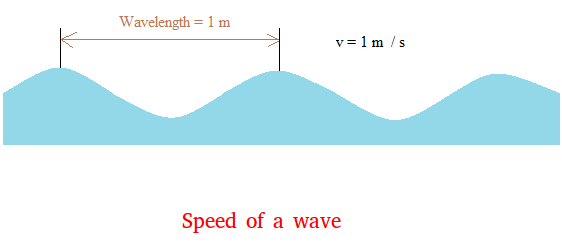Speed of a wave
The speed of a wave, the frequency of a wave, and the wavelength of a wave are all related. Suppose you are closely observing the waves of the sea with a stopwatch and you made the following observation.

1 cycle every second.
Wavelength = 1 meter
Recall that 1 cycle every second means that after you see the first crest, it will take 1 second to see another.
The wavelength is the horizontal distance a crest moves each second.
Since the wavelength or distance between two crests is 1 meter and it takes 1 second for this wavelength to form, the speed of the wave is 1 meter per second.
(1 times 1)
In many cases, you may see more than 1 crest in one second.
Example #2
Pretend the frequency is 3 cycles in 1 second and the wavelength is 1 meter.
If one cycle creates a wavelength of 1 meter, then 3 cycles will give a distance of 3 meters.
If the wave moves 3 meters every second, then the speed is 3 meters per second. (3 times 1)
Example #3
Pretend the frequency is 3 cycles in 1 second and the wavelength is 2 meters.
If one cycle creates a wavelength of 2 meters, 3 cycles will give a distance of 6 meters.
If the wave moves 6 meters every second, then, the speed is 6 meters per second. (3 times 2)
Important observations about the speed of a wave
Notice that we can get the speed of the wave if we just multiply the frequency and the wavelength together.
In example #3 for instance, the frequency is 3 cycles in 1 second and the wavelength is 2 meters.
Speed = frequency times wavelength = 3 times 2 = 6 m / s
Generally speaking we use the Greek letter Lambda Λ to represent the wavelength.We write v = f × Λ
Exercises about the speed of a wave
Exercise #1: A wave has a frequency of 20 Hertz and a wavelength of 8 meters. Use the formula above to find the speed of the wave.
We write v = f × ΛWe write v = 50 Hertz × 8 meters
We write v = 400 meters per second
Exercise #2: A wave has a frequency of 0.5 Hertz and a wavelength of 5 meters. Use the formula above to find the speed of the wave.
We write v = 0.5 Hertz × 5 meters
We write v = 2.5 meters per second